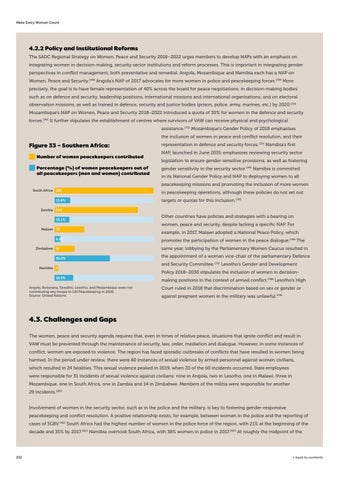Make Every Woman Count
4.2.2 Policy and Institutional Reforms The SADC Regional Strategy on Women, Peace and Security 2018–2022 urges members to develop NAPs with an emphasis on integrating women in decision-making, security sector institutions and reform processes. This is important in integrating gender perspectives in conflict management, both preventative and remedial. Angola, Mozambique and Namibia each has a NAP on Women, Peace and Security.1788 Angola’s NAP of 2017 advocates for more women in police and peacekeeping forces.1789 More precisely, the goal is to have female representation of 40% across the board for peace negotiations; in decision-making bodies such as on defence and security, leadership positions, international missions and international organisations; and on electoral observation missions, as well as trained in defence, security and justice bodies (prison, police, army, marines, etc.) by 2020.1790 Mozambique’s NAP on Women, Peace and Security 2018–2022 introduced a quota of 30% for women in the defence and security forces.1791 It further stipulates the establishment of centres where survivors of VAW can receive physical and psychological assistance.1792 Mozambique’s Gender Policy of 2018 emphasises the inclusion of women in peace and conflict resolution, and their
Figure 33 – Southern Africa: Number of women peacekeepers contributed Percentage (%) of women peacekeepers out of all peacekeepers (men and women) contributed
representation in defence and security forces.1793 Namibia’s first NAP, launched in June 2019, emphasises reviewing security sector legislation to ensure gender-sensitive provisions, as well as fostering gender sensitivity in the security sector.1794 Namibia is committed in its National Gender Policy and NAP to deploying women to all peacekeeping missions and promoting the inclusion of more women
South Africa 183 15.8%
in peacekeeping operations, although these policies do not set out targets or quotas for this inclusion.1795
Zambia 154 15.1%
Other countries have policies and strategies with a bearing on women, peace and security, despite lacking a specific NAP. For
Malawi 55 6.2% Zimbabwe 37 56.0% Namibia 7 18.9% Angola, Botswana, Eswatini, Lesotho, and Mozambique were not contributing any troops to UN Peacekeeping in 2020. Source: United Nations.
example, in 2017, Malawi adopted a National Peace Policy, which promotes the participation of women in the peace dialogue.1796 The same year, lobbying by the Parliamentary Women Caucus resulted in the appointment of a woman vice-chair of the parliamentary Defence and Security Committee.1797 Lesotho’s Gender and Development Policy 2018–2030 stipulates the inclusion of women in decisionmaking positions in the context of armed conflict.1798 Lesotho’s High Court ruled in 2018 that discrimination based on sex or gender or against pregnant women in the military was unlawful.1799
4.3. Challenges and Gaps The women, peace and security agenda requires that, even in times of relative peace, situations that ignite conflict and result in VAW must be prevented through the maintenance of security, law, order, mediation and dialogue. However, in some instances of conflict, women are exposed to violence. The region has faced sporadic outbreaks of conflicts that have resulted in women being harmed. In the period under review, there were 60 instances of sexual violence by armed personnel against women civilians, which resulted in 24 fatalities. This sexual violence peaked in 2019, when 20 of the 60 incidents occurred. State employees were responsible for 31 incidents of sexual violence against civilians: nine in Angola, two in Lesotho, one in Malawi, three in Mozambique, one in South Africa, one in Zambia and 14 in Zimbabwe. Members of the militia were responsible for another 29 incidents.1800 Involvement of women in the security sector, such as in the police and the military, is key to fostering gender-responsive peacekeeping and conflict resolution. A positive relationship exists, for example, between women in the police and the reporting of cases of SGBV.1801 South Africa had the highest number of women in the police force of the region, with 21% at the beginning of the decade and 35% by 2017.1802 Namibia overtook South Africa, with 38% women in police in 2017.1803 At roughly the midpoint of the
232
> back to contents

